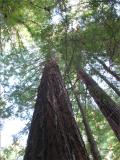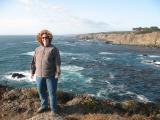Kenneth E. Harker
2009
Mendocino
County,
California
Jen and I spent a weekend in October in Mendocino County, California. We've
already explored a lot of northern California, with multiple trips to both
Napa County and Sonoma County. This was our first trip as far north as
Mendocino County, north of Sonoma County. We stayed in the coastal town of
Fort Bragg, and in addition to
wine tasting
in the Anderson Valley and the
Ukiah Valley, we spent some time exploring the redwood forests and
visiting with sea lions at the Pacific Ocean.
These photos are copyright © 2009 Kenneth E. Harker.
All rights reserved.
Hare Creek, Fort Bragg |
Navarro River Redwoods State Park |
Navarro Point Preserve |
Glass Beach, Fort Bragg
Hare Creek, Fort Bragg
We spent two nights at the
Holiday Inn
Express in Fort Bragg,
California. Fort Bragg is a small town on the northern California
coast, about 175 miles north-northwest of San Francisco. Founded in 1857
as a military fort, it was named after Braxton Bragg, an officer in the
U.S. Army who would later become a general in the army of the Confederacy.
The fort was abandoned by 1867, but the town grew with new settlers. The
town has a long history with the lumber industry, and was a major source
of the lumber that rebuilt San Francisco following the earthquake and
fire of 1906. Today, Fort Bragg is becoming a tourist resort. Summer is
the peak tourist season, so the town was not as busy while we were there.
 |
Our hotel in Fort Bragg was perched above a scenic greenbelt along Hare
Creek, just about 500 meters (1/3 mile) from the Pacific Ocean on the south
side of the town. In the morning, the coastal fog rolled into the creek basin
and softened the view of the trees in the distance.
|
 |
There were almost no buildings visible through the trees in the creek basin.
Hare Creek is somewhere down in the bushes and trees. The main waterway in
Fort Bragg is the Noyo River, which was not far to the north of our hotel.
|
 |
From the balcony of our room, you could see the Pacific Ocean just beyond
the Pacific Coast Highway, also known as California State Route 1. Our
hotel was about 80 feet (24 meters) above sea level.
|
 |
In the evening, the setting sun highlighted the few bits of orange and red
in the trees. California doesn't get the same intensity of fall colors
in the trees as other parts of the country. It was also really too early
in the season for fall color; the best fall foliage was yet to come.
|
 |
The sun starting to set over the Pacific Ocean and our little creek.
|
Navarro River Redwoods State Park
The Navarro River
Redwoods State Park is in an eleven mile long, narrow valley of
second-growth redwood forest along the lower Navarro River valley. All
of the original growth redwood forest in the county was cut down long
before we were born. In October, all the campgrounds and other services
in the park are closed, but there are many places to pull off the road
(California State Route 128) and go for a walk in the trees. We drove
through the state park twice, on our way to the
Anderson
Valley in the morning, and then again on our way back to Fort Bragg
in the afternoon. The redwood trees in this state park are not as big
as the old growth redwoods in the
Muir Woods
National Monument, which we visited in 2004.
 |
In the morning, the light through the trees was very pretty.
|
 |
The huge root stock from a fallen redwood. Root stock much smaller than this
would merit marking on an orienteering map.
|
 |
Looking up the trunk of a big redwood tree.
|
 |
Some more redwoods.
|
 |
Jen in the forest.
|
 |
Some fallen branches covered in moss and ferns.
|
 |
Not all of the trees in the forest were redwoods, and not all of
the redwoods were mature, full-size trees.
|
 |
Ken, next to the big trees.
|
 |
A view through the trees.
|
 |
These trees are not redwoods.
|
 |
In the late afternoon, we drove back through the "redwood tunnel to the sea".
The forest was darker and felt deeper.
|
 |
Three big redwoods, surrounded by smaller trees.
|
 |
Afternoon sunlight filtering through the redwoods.
|
 |
Much of the forest floor was covered in ferns.
|
 |
More sunlight streaming through the canopy.
|
 |
Jen, in front of a redwood stump that was about six feet in diameter.
|
 |
It seems surprising to me that these huge trees can grow so close to one
another.
|
 |
This was one of the prettier stands of redwoods in the state park.
|
 |
Big trees everywhere.
|
Navarro Point Preserve
The Navarro Point Preserve is a 56-acre (23 ha) public
park owned and managed by the
Mendocino Land Trust. Navarro Point extends out into the Pacific Ocean
just north of the mouth of the Navarro River. The park is a mix of coastal
prairie grass, coastal scrub, some wetlands, and steep cliffs down to the
ocean. There are over a mile of trails through the fields, but we only hiked
the main loop from the parking area by the highway to the headland and back.
A strong onshore wind was blowing, making for a cold walk.
 |
The sign in the parking lot laying down the rules. There were a couple
of other cars full of people visiting the afternoon we were there.
|
 |
The view from the parking area toward the north. The house in the distance
was just outside the park boundaries.
|
 |
Jen looks cold. The hills behind her were on the other side of California
State Route 1 and outside the park boundaries. I'm sure the house on top of
the hill is an expensive property with spectacular ocean views.
|
 |
The trail through the prairie grass toward the cliffs over the ocean.
|
 |
Looking north. The vegetation near the trail here is more scrub than grasses.
|
 |
Looking south from the top of the cliffs over the beach. These cliffs are
about 160 feet (50 meters) high, and there was no obvious safe route down
them to the beach.
|
 |
The cliffs to the north of Navarro Point.
|
 |
The beach is all rocks and gravel and just looked really cold.
|
 |
There was a stiff onshore wind blowing over the point. It was cold.
|
 |
Some rocks at the bottom of the cliffs.
|
 |
A raft of sea lions hauled out on the rocks far below us on the
south side of the point. There was no practical way to get any closer
to them, which was probably a good thing from the sea lions' perspective.
|
 |
Looking south into the distance.
|
 |
This is looking north. There was lots of seaweed in the water on this side
of the point.
|
 |
Looking south at the cliffs over the beach glowing in the setting sun.
|
 |
Ken, at the far end of Navarro Point. It was really windy.
|
 |
Jen was dressed a little more appropriately for the cold wind.
|
 |
Looking northeast from the point back at the coast. The cliffs are about
160 feet (50 meters) tall. The homes on the hills are about 400 feet
(120 meters) above sea level.
|
 |
Walking back to the car, we again walked by the raft of about a dozen
sea lions sunning themselves on the rocks at the base of the cliff.
Most of the sea lions had spotted gray coats, but the bright sunlight
made some of them look almost white.
|
 |
Jen, on the trail back to the car.
|
Glass Beach, Fort Bragg
Just before sunset, we made a quick visit to Glass Beach on the north
side of Fort Bragg. This beach was used as the public dump for the town
for most of the twentieth century. Residents would simply carry their
garbage to the top of the cliffs and toss it over the side. In 1967, dumping
was stopped and cleanup efforts began to cleanse the beach. A legacy of the
dump remains - millions of tiny fragments of sea glass, from broken glass worn
smooth by the waves and beach gravel. Glass Beach is now a public park and
something of an ironic eco-tourist attraction.
 |
We arrived at the beach just before sunset.
|
 |
Like most of the northern California coast, the beach is mostly rocks
and gravel.
|
 |
These were the cliffs from which the town residents would hurl their garbage
into the sea.
|
 |
The brown sea glass stands out most prominently, but there was a lot
of off-white sea glass as well. Probably a third of the gravel in this photo
is really glass rather than rock.
|
 |
A big square rock offshore.
|
 |
Ken, just at sunset.
|
 |
The sunset over the Pacific Ocean.
|
 |
A line of clouds was on the horizon in the distance over the ocean.
|
|
Last Updated 1 August 2018
|




